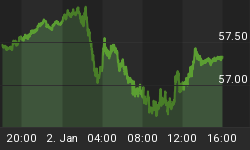The S&P 500 has grown over the 60+ years since 1947 at a rate of 6.8% through the March low of 2009, the same rate of growth of the GDP over the same period. If we take for the sake of argument that the GDP is an attractor value for the price growth level of the S&P 500, then the index would be expected to end 2010 at about 1055 (11 points, or 1%, below the close last Friday).
That GDP/S&P500 assumption is perhaps a false assumption, but the correlation seems reasonable from 1947 through the mid-1980's when interest rates began to fall dramatically, followed by the dot.com bubble. By ignoring the huge rise and fall, and rise again and fall again since the mid-1990's, the March 2009 low touched the 6.8% compound growth curve shown in the graph below ...
![]() A Look At The S&P 500 After A Tough Week
A Look At The S&P 500 After A Tough Week
















